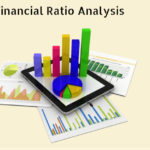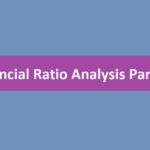Balance Sheet Description
A company’s P&L account gives us an idea of the company’s profit and loss, while the balance sheet gives us an idea of the company’s assets, liabilities, and shareholders’ shares. The P&L statement gives information about a single financial year, so it can be treated as a separate statement. Whereas on the other hand the balance sheet is a statement that shows the changes in the position of the company since its inception. This shows how the company has been changing financially.
Let’s take a look at the Balance Sheet of Amara Raja Batteries Limited (ARBL)-
You can see that the information about assets, liabilities and equity is given in the balance sheet.
In the previous chapter we talked about assets. The company has both tangible assets and intangible assets. An asset is an asset that is held by a company and has a price for the company. Generally, the assets we know about are factories, machines, cash, brands, patents, etc. We will discuss about them in detail further.
Liabilities or Liabilities are called the responsibilities of the company which it has to fulfill. The company takes these responsibilities because it feels that it will get financial benefits from them in future. Simply put, this is a kind of debt, which the company will have to pay in future. Examples of liabilities are short and long term debt, any kind of payment etc. There are 2 types of Liabilities- 1) Current Liability 2) Non Current Liability. We will discuss these further.
Generally, the total assets of the company in the balance sheet are equal to the total liabilities of the company.
Assets = Liabilities
This equation is called balance sheet equation or accounting equation. This equation tells that the balance sheet should always be balanced. That is, assets and liabilities must be equal. This happens because the company buys each asset either from the owner’s capital or out of a liability.
The difference between an asset and a liability is the owner’s capital, which we call the owner’s capital. It is also called shareholder’s equity or net worth of the company. If you look at the equation
Shareholders equity = Assets – Liabilities
Shareholder Fund Information
As we know that balance sheet consists of two parts – assets and liabilities. Liability describes the responsibilities of the company. Shareholder funds also come under liabilities in the balance sheet. You can see it in the picture below. Some people remain a little skeptical about it.

This doubt arises because when we are talking about liability, we are actually saying what are the responsibilities on the company, whereas shareholder fund shows the capital of the company. So seeing these two together in the balance sheet creates a bit of doubt as the shareholder fund should actually be an asset and not a liability.
To understand this, you have to change the way you look at the company’s financial statements. Suppose the company is a person whose job it is to generate capital for its shareholders. Viewed this way, you are looking at separating the shareholders of the company (which includes the promoters of the company) from the company. Viewed from this point of view, you will understand that the company gives information about its financial condition in any financial statement.
This also means that the shareholder fund is not the property of the company, it is the property of the shareholders of the company. Therefore, the company has to show the shareholder fund as a responsibility which it is going to pay later. Hence it is shown as a liability in the balance sheet.
The liability portion of the balance sheet
In the Liabilities section of the Balance Sheet, a company shows its liabilities in 3 parts – Shareholders Fund, Non Current Liability and Current Liability. The first part is of Shareholders Fund.
To understand share capital properly, imagine a company that is issuing its shares for the first time. Suppose the name of the company is ABC and it issues 1000 shares of face value of Rs.10. So the share capital is 10 × 1000 = 10000. (Face Value × Number of Shares)
In the case of ARBL, the share capital is Rs.17.081 crores. While the face value is Rs.
We can find the total number of outstanding shares by using face value and share capital value. We know it
Share Capital = FV (Face Value) * Number of Shares
Therefore, number of shares = share capital / FV (face value)
So in case of ARBL,
Number of shares = 17,08,10,000 / 1
= 17,08,10,000 shares
The next line item in the liability section of the balance sheet is “Reserves and Surplus”. Reserves are the amount that the company keeps aside for a specific purpose. Surplus is the amount where the profit of the company is shown. The amount of Reserve and Surplus for ARBL is Rs.1345.6 crores. The note number associated with reserve and surplus is 3. See it in the picture below.
 As you can see the company has divided the total amount into 3 types of reserves.
As you can see the company has divided the total amount into 3 types of reserves.
Capital Reserve – These are the money that the company keeps for long-term projects. ARBL has not shown much amount in Capital Reserve. Although this amount belongs to the shareholders but cannot be distributed to them.
Securities Premium Reserve / Account – Whatever premium is there on the face value of the company’s shares, that amount is kept in this reserve. ARBL has kept Rs 31.18 crore under this.
General Reserve – This is the reserve where all the profits of the company so far accumulated (which have not been distributed among the shareholders) are shown. The company uses this amount in case of any financial crisis. ARBL has kept Rs 218.4 crore under this.
The next part of the balance sheet is the surplus. As we have mentioned earlier that in surplus, the entire amount of profit for the year is shown. Here are some things you should pay attention to.
The surplus in the balance sheet of last year (FY13) was 829.8 crores. It is shown as the first line of surplus in the figure below.
 The profit of this financial year (FY14) which is 367.4 crores has been added to the closing balance of the previous year’s surplus. Here are a few things to note-
The profit of this financial year (FY14) which is 367.4 crores has been added to the closing balance of the previous year’s surplus. Here are a few things to note-
Note how the P&L statement is linked to the balance sheet. It is pointing out an important thing and that is that all the three financial statements are interlinked.
Note how the balance sheet amount from last year is added to this year’s amount. This shows that the balance sheet is prepared in a flow pattern, where the previous year’s amount is carried over to the next year.
Last year’s balance and this year’s profit together make up an amount of 1197.2 crores. The company can use this amount for different things.
First of all, some amount is put in the general reserve in the company, so that this amount can be useful in future. The company has kept Rs 36.7 crore for this.
After putting the money in the General Reserve, the company has distributed Rs 55.1 crore as dividend, on which it has to pay dividend distribution tax of Rs 9.3 crore.
After this the company has a surplus of Rs 1095.9 crore. This will be the opening balance of the surplus in the balance sheet for the next year (FY15).
Total Reserve and Surplus = Capital Reserve + Securities Premium Reserve + General Reserve + Year’s Surplus. For FY14 this amount is made 1345.6 crores whereas in FY13 this amount was 1042.7 crores.
The amount formed by combining share capital, reserves and surplus is the total shareholder fund. Since this amount belongs to the shareholders of the company, it is shown in the liability section of the balance sheet.
Non-Current Liabilities
Non-current Liabilities are long-term responsibilities of the company which the company is not going to fulfill within 365 days/12 months. These responsibilities are reflected in the accounts of the company for years.
Let us see the non-current liability of ABRL in this figure.
 The company has shown 3 types of non-current liabilities. Let’s take a look at them.
The company has shown 3 types of non-current liabilities. Let’s take a look at them.
Long Term Debt – Long Term Borrowing (linked to Note 4) – This is the first line item of Non Current Liability. This is the most important figure in the balance sheet as it shows all the places the company has taken loans from. Long-term debt figures are also used to work out certain financial ratios. We will discuss this further in this module.
Take a look at the note on long-term debt.
 It is clear from this note that here long term borrowing means interest free sales tax deferment (). To explain this, the company has written something just below the note, which has been highlighted in red. It seems that this is some tax incentive from the state government, which the company is going to pay in a little more than 14 years.
It is clear from this note that here long term borrowing means interest free sales tax deferment (). To explain this, the company has written something just below the note, which has been highlighted in red. It seems that this is some tax incentive from the state government, which the company is going to pay in a little more than 14 years.
You will find many such companies which do not have long term borrowing or debt. Although it is a good thing that the company does not have debt, but you have to ask why there is no debt. Whether the banks do not want to give loans to the company or the company is not taking any steps to increase its business. When we analyze the balance sheet, then we will find the answer to this question.
Remember that when a company’s debt is high, its finance cost is also high. When we were discussing P&L, we knew this under the line item of finance cost.
The next line item in non current liability is Deferred tax liability. When the company arranges money for future tax payments, it is called deferred tax liability. You should think here that what does the company do so that it has to pay more tax in future and arrange for it now.
This is because depreciation is treated in a special way under the Companies Act and Income Tax. We will not talk much on this right now but remember that deferred tax liability is directly related to depreciation.
The last line item of Non Current Liability is Long Term Provisions. This is the amount that the company spends on the employees. This includes things like gratuity, leave encashment, provident fund.
Current Liabilities
Current Liabilities are the responsibilities of the company which the company has to fulfill within 365 days i.e. 1 year. The current here means that these responsibilities will be fulfilled soon. Remember that non current responsibilities are fulfilled after 1 year.
Let us see an example- if you buy a mobile phone on EMI (via credit card) then it is clear that you intend to repay the loan to the credit card company in a few months. This is your current liability, but if you buy a flat and want to repay the loan to the housing finance company in 15 years, then it will be your non-current liability.
Check out the current liability of ARBL below
 You can see that there are 4 line items in the current liability. The first is Short Term Borrowing. As the name suggests, it refers to the cash requirement that the company needs for its day-to-day needs (Working Capital). Below we have shown a section of Note 7 explaining the meaning of short-term borrowing.
You can see that there are 4 line items in the current liability. The first is Short Term Borrowing. As the name suggests, it refers to the cash requirement that the company needs for its day-to-day needs (Working Capital). Below we have shown a section of Note 7 explaining the meaning of short-term borrowing.
As you can see the company has taken short-term loan from State Bank of India and Andhra Bank as working capital. Trying to keep short-term borrowings to a minimum. Here this amount is Rs 8.3 crore.
The next line item is – Trade Payable – Trade Payable (also known as Account Payable – Account Payable). Here this amount is Rs 127.7 crore. This is the amount that the company has to pay to its vendors/suppliers. Such as suppliers selling raw materials, companies providing electricity and water, companies providing stationery etc. This is shown in detail in Note 8 below. The next line item is other current liability, which is Rs 215.6 crore here. Usually these liabilities are related to legal requirements that have no direct relation to the business of the company. You can understand it in Note 9 below.
The next line item is other current liability, which is Rs 215.6 crore here. Usually these liabilities are related to legal requirements that have no direct relation to the business of the company. You can understand it in Note 9 below.
The last line item in the current liability is Short Term Provisions (). Here it is Rs 281.8 crore. It is similar to long-term provisions. In both, things like gratuity, provident fund have been arranged for the employees of the company. You will notice that both have the same note.
Since Note 6 on long term and short term provisions lasts for several pages, I am not going to go into detail. You may also refer to pages 80, 81, 82 and 83 of ARBL’s FY14 Annual Report.
Well, in the context of financial statements, all you need to know is that both (long term and short term provisions) are related to the facilities available to the employees. You can get complete information about them through the note attached to them.
So far we have understood half of the balance sheet which had the liabilities part. Take a look at the balance sheet once again so that you understand it properly.
It is clean,
Total Liability = Shareholders Fund + Non Current Liability + Current Liability
= 1362.7+143.03+633.7
Total Liability = Rs 2139.4 crore
Highlights of this chapter
- The balance sheet is also called statement of financial position. It is prepared in the form of a flow to get an accurate idea of the financial position of the company at any given point of time. This statement shows the assets and liabilities of the company.
- A company needs a balance sheet when it needs money from investors or has to take loans or pay taxes.
The balance sheet equation is Asset = Liability + Shareholder Equity - Liability is the company’s liabilities or debt, while share capital is the number of shares × face value
Reserves mean the amount that the company has kept for a particular reason, and it is to be used in the future. - Surplus is where the profit of the company is shown. It is used in both the company’s balance sheet and P&L. Dividend is paid out of surplus only.
- Shareholders Equity = Share Capital + Reserve + Surplus.
- Non Current Liability or Long Term Liability are those which the company does not have to pay in the next 365 days.
- Deferred tax liability arises because of a certain view of depreciation. Depreciation is treated differently in the eyes of the company’s account and income tax department, hence creating a deferred tax liability.
- Current Liability is the responsibility that the company has to meet within 365 days.
- Generally, long and short term provisions have the liability which is linked to the facilities of the employees.
- Total Liability = Shareholders Fund + Non Current Liability + Current Liability. This is the amount that the company has to pay to other people.

Gaurav Heera is a leading stock market educator, offering the best stock market courses in Delhi. With expertise in trading, options, and technical analysis, he provides practical, hands-on training to help students master the markets. His real-world strategies and sessions make him the top choice for aspiring traders and investors.










